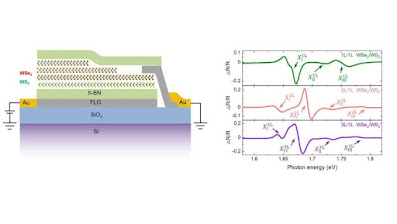A design to tune moiré excitons in TMDC superlattices through varying layer degrees of freedom
Transition metal dichalcogenides (TMDCs) are an emerging and promising class of materials comprised of a transition metal atomic layer sandwiched between two layers of chalcogen atoms. These 2D materials have received considerable attention over the past few years, as they can give rise to strong electronic correlations and fascinating correlated states, enabling the production of moiré excitons (i.e., bound electron-hole pairs).
Listen this article in our podcast.
Moiré excitons could open new possibilities for the creation of new, highly performing devices, including lasers, single-photon emitters and quantum technologies. For these devices to effectively operate, however, physicists and computer scientists should be able to reliably tune both moiré excitons and electronic states.
Researchers at the University of Rensselaer Polytechnic Institute, UC Riverside, and other institutes in the U.S., China and Japan have recently introduced a new strategy to tune moiré excitons and correlated electronic states in TMDCs. This method, introduced in a paper published in Nature Communications, entails the manipulation of degrees of freedom between TMDC layers.
"Previous works, including our own works, have shown that WS2/WSe2 moiré superlattices exhibit both moiré modulation of excitons and strong electron-electron correlation, which gives rise to exciting opportunities in moiré excitonics and correlated physics," Sufei Shi, one of the researchers who carried out the study, told Phys.org. "In our recent study, we wanted to demonstrate the capabilities of further tuning the excitonic physics and electron correlation through layer degree of freedom."
To introduce layer degree of freedom into their WS2/WSe2 superlattice, the researchers tuned the WSe2 from monolayer to bilayer and trilayer. They then observed the impact that these changes had on the material's moiré excitons and electronic states.
"We constructed the WS2/WSe2 using monolayer, bilayer and trilayer WSe2," Shi explained. "The monolayer to trilayer WSe2 can be obtained through a process known as mechanical exfoliation, and we tried to find regions with different layers in the same flake, so that we could compare them directly during experiments."
The experiments carried out by Shi and his colleagues yielded very interesting results. Most notably, the researchers found that by changing the layer degree of freedom they could reliably modulate the resonances of moiré excitons in the material. This highlights the potential of their strategy for sensitively tuning moiré exciton bands in TMDCs and potentially other superlattices.
"We also found that the electron correlation is retained even for trilayer WSe2, despite the increased dielectric screening," Yong-Tao Cui, another senior author of this work, said. "This suggests that we can combine knobs such as electric field to engineer new states in the multilayer WSe2/WS2 moiré system. Our recent paper (Nature Physics 18, 1171–1176, 2022) on excitonic insulator state in the bilayer WSe2/ monolayer WS2 is a result of that."
The new method for tuning the strong electronic correlations and moiré excitons introduced by Shi and his colleagues opens up exciting opportunities for both research and technology development. Most notably, it could be used by researchers worldwide to study and engineer various quantum phenomena.
"We now want to further apply the electric field and search for new correlated states that can be engineered in this system, especially those with a nontrivial topology," Shi added.
For more such news & interesting articles or how can it affect in your life subscribe to our newsletter


Comments
Post a Comment